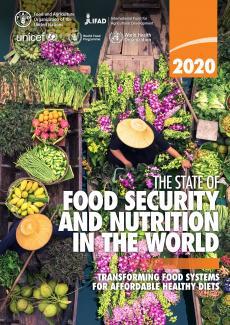
https://data.unicef.org/resources/sofi-2020/
This year, the report presents evidence that a healthy diet costs far more than US$ 1.90/day, the international poverty threshold.
A staggering 3 billion people or more cannot afford a healthy diet. In sub-Saharan Africa and southern Asia, this is the case for 57 percent of the population – though no region, including North America and Europe, is spared. Partly as a result, the race to end malnutrition appears compromised.
The report indicates that the burden of malnutrition in all its forms remains a challenge and that while the world has been making some progress against some of the 2030 SDG nutrition targets — it has been uneven and insufficient to meet the goals.
As of the end of 2019, exclusive breastfeeding only was on track for the 2025 target; stunting showed some progress although insufficient to achieve either the 2025 or 2030 targets, the prevalence of wasting was notably higher than the targets and achievement of the 2030 child overweight target would require a reversal of the current trajectory.
The onset of COVID-19 in 2020 throws into further doubt the achievement of these goals especially as the nutritional status of the most vulnerable population groups is likely to deteriorate further due to the health and socio-economic impacts of the pandemic.
KEY MESSAGES
Updates for many countries have made it possible to estimate hunger in the world with greater accuracy this year. In particular, newly accessible data enabled the revision of the entire series of annual undernourishment estimates for China back to 2000, resulting in a substantial downward shift of the series of the number of undernourished in the world.
Nevertheless, the revision confirms the trend reported in past editions: the number of people affected by hunger globally has been slowly on the rise since 2014. è Current estimates are that nearly 690 million people are hungry, or 8.9 percent of the world population – up by 10 million people in one year and by nearly 60 million in five years.
The number of people affected by severe food insecurity, which is another measure that approximates hunger, shows a similar upward trend. In 2019, close to 750 million – or nearly one in ten people in the world – were exposed to severe levels of food insecurity.
Considering the total affected by moderate or severe food insecurity, an estimated 2 billion people in the world did not have regular access to safe, nutritious and sufficient food in 2019.
The world is not on track to achieve Zero Hunger by 2030. If recent trends continue, the number of people affected by hunger would surpass 840 million by 2030. è A preliminary assessment suggests that the COVID-19 pandemic may add between 83 and 132 million people to the total number of undernourished in the world in 2020 depending on the economic growth scenario.
Globally, the burden of malnutrition in all its forms remains a challenge. According to current estimates, in 2019, 21.3 percent (144.0 million) of children under 5 years of age were stunted, 6.9 percent (47.0 million) wasted and 5.6 percent (38.3 million) overweight.
The world is making progress but is not on track to achieve the 2025 and 2030 targets for child stunting and low birthweight, and for exclusive breastfeeding, is on track only for the 2025 target.
The prevalence of wasting is notably above the targets. Most regions are not on track to achieve the targets for child overweight. Adult obesity is on the rise in all regions. Urgent action is needed to reverse these upward trends.
The nutritional status of the most vulnerable population groups is likely to deteriorate further due to the health and socio-economic impacts of COVID-19.
Food insecurity can worsen diet quality and consequently increase the risk of various forms of malnutrition, potentially leading to undernutrition as well as overweight and obesity.
Low-income countries rely more on staple foods and less on fruits and vegetables and animal source foods than high-income countries. Only in Asia, and globally in upper-middle-income countries, are there enough fruits and vegetables available for human consumption to be able to meet the FAO/WHO recommendation of consuming a minimum of 400 g/person/day.
While we still face significant challenges in just accessing food, challenges are even more important in terms of accessing healthy diets.
Healthy diets are unaffordable to many people, especially the poor, in every region of the world. The most conservative estimate shows they are unaffordable for more than 3 billion people in the world. Healthy diets are estimated to be, on average, five times more expensive than diets that meet only dietary energy needs through a starchy staple.
The cost of a healthy diet exceeds the international poverty line (established at USD 1.90 purchasing power parity (PPP) per person per day), making it unaffordable for the poor. The cost also exceeds average food expenditures in most countries in the Global South: around 57 percent or more of the population cannot afford a healthy diet throughout sub-Saharan Africa and Southern Asia.
All diets have hidden costs, which must be understood to identify trade-offs and synergies in relation to other SDGs. Two hidden costs that are most critical relate to the health (SDG 3) and climate-related (SDG 13) consequences of our dietary choices and the food systems that support these.
Under current food consumption patterns, diet-related health costs linked to mortality and non-communicable diseases are projected to exceed USD 1.3 trillion per year by 2030. On the other hand, the diet-related social cost of greenhouse gas emissions associated with current dietary patterns is estimated to be more than USD 1.7 trillion per year by 2030.










Add new comment